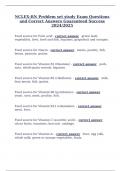NCLEX-RN Problem set study Exam Questions
and Correct Answers Guaranteed Success
2024/2025
Food source for Folic acid - correct answer green leafy
vegetables, liver, beef and fish, legumes, grapefruit and oranges.
Food source for Niacin - correct answer meats, poultry, fish,
beans, peanuts, grains.
Food source for Vitamin B1 (thiamine) - correct answer pork,
nuts, whole-grain cereals, legumes.
Food source for Vitamin B2 (riboflavin): - correct answer milk,
lean meats, fish, grains.
Food source for Vitamin B6 (pyridoxine): - correct answer
yeast, corn, meat, poultry, fish.
Food source for Vitamin B12 (cobalamin): - correct answer
meat, liver.
Food source for Vitamin C (ascorbic acid): - correct answer
citrus fruits, tomatoes, broccoli, cabbage.
Food source for Vitamin A: - correct answer liver, egg yolk,
whole milk, green or orange vegetables, fruits.
,Food source for Vitamin D: - correct answer fortified milk, fish
oils, cereals.
Food source for Vitamin E: - correct answer vegetable oils,
green leafy vegetables, cereals, apricots, apples, peaches.
Food source for Vitamin K: - correct answer green leafy
vegetables, cauliflower, cabbage.
Food source for Calcium: - correct answer broccoli, carrots,
cheese, collard greens, green beans, milk, rhubarb, spinach, tofu,
yogurt.
Food source for Chloride - correct answer salt.
Food source for Iron - correct answer bread and cereals, dark
green vegetables, dried fruits, egg yolk, legumes, liver, meats.
Food source for Magnesium - correct answer avocado, canned
white tuna, cauliflower, cooked rolled oats, green leafy
vegetables, milk, peanut butter, peas, pork, beef, chicken,
potatoes, raisins, yogurt.
Food source for Phosphorus - correct answer fish, nuts, organ
meats, pork, beef, chicken, whole-grain bread and cereals.
Food source for Potassium - correct answer avocado, banana,
cantaloupe, carrots, fish, mushrooms, oranges, pork, beef, veal,
potatoes, raisins, spinach, strawberries, tomatoes.
,Food source for Sodium - correct answer American cheese,
bacon, butter, canned food, cottage cheese, cured pork, hot dogs,
ketchup, milk, mustard, processed food, soy sauce, table salt,
white and whole-wheat bread.
Food source for Zinc - correct answer eggs, leafy vegetables,
meats, protein-rich foods.
Auscultation location for aortic sound - correct answer Right
2nd intercostal space
Auscultation location for pulmonic sound - correct answer Left
2nd intercostal space
Auscultation location for ERB's point - correct answer (S1, S2)
Left 3rd intercostal space
Auscultation location for Mitral sound - correct answer Left
5th intercostal, medial to midclavicular line
Crackles - correct answer High pitched and heard during
inspiration. Not cleared by cough. Discontinuous. Clinical
examples include pneumonia, heart failure, asthma, restrictive
pulmonary diseases; if coarse crackles: pulmonary edema and
pulmonary fibrosis and also in patients terminally ill with
diminished gag reflex.
Rhonchi - correct answer Rumbling, course sounds like a
snore. Heard during inspiration or expiration. May clear with
, coughing or suctioning. Continuous. Heard in patients with
chronic bronchitis.
Wheezes - correct answer musical noise during inspiration or
expiration. Usually louder during expiration. May clear with
cough. Continuous. Heard in patients with asthma.
Pleural friction rub - correct answer Superficial, low pitched,
coarse rubbing or grating sound (two surfaces rubbing each
other). Heard throughout inspiration or expiration. Not cleared
by cough. Heard in patients with pleurisy.
Ventilator High-pressure alarm: - correct answer - Increased
secretions are in the airway.
- Wheezing or bronchospasm is causing decreased airway size. -
The endotracheal tube is displaced.
- The ventilator tube is obstructed because of water or a kink in
the tubing.
- Patient coughs, gags, or bites on the oral endotracheal tube.
- Client is anxious or fights the ventilator.
Ventilator Low-pressure alarm: - correct answer -
Disconnection or leak in the ventilator or in the patient's airway
cuff occurs.
- The patient stops spontaneous breathing.
Chest tube: Suction control chamber - correct answer - Gentle
bubbling indicates that there is suction and does not indicate
that air is escaping from the pleural space.




